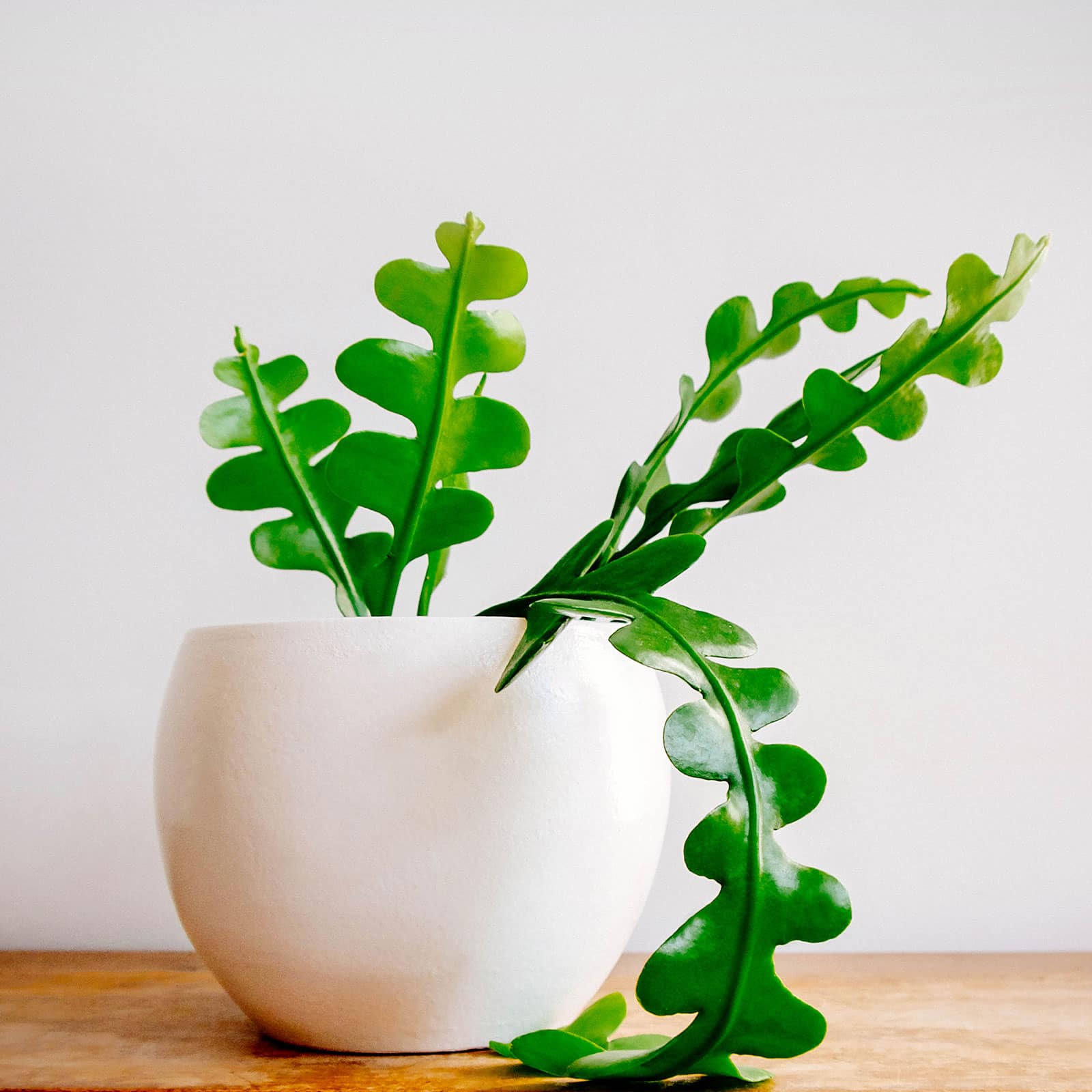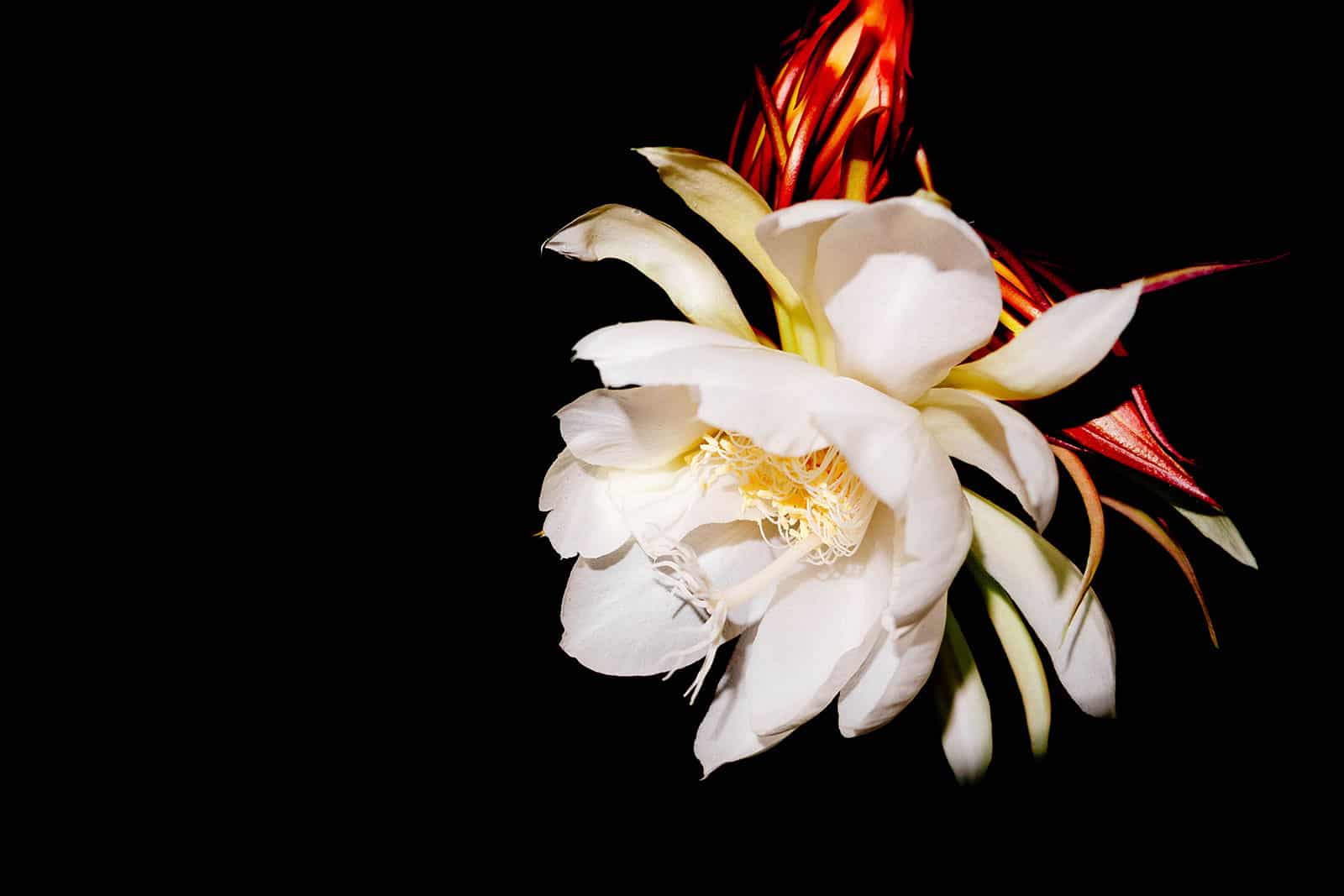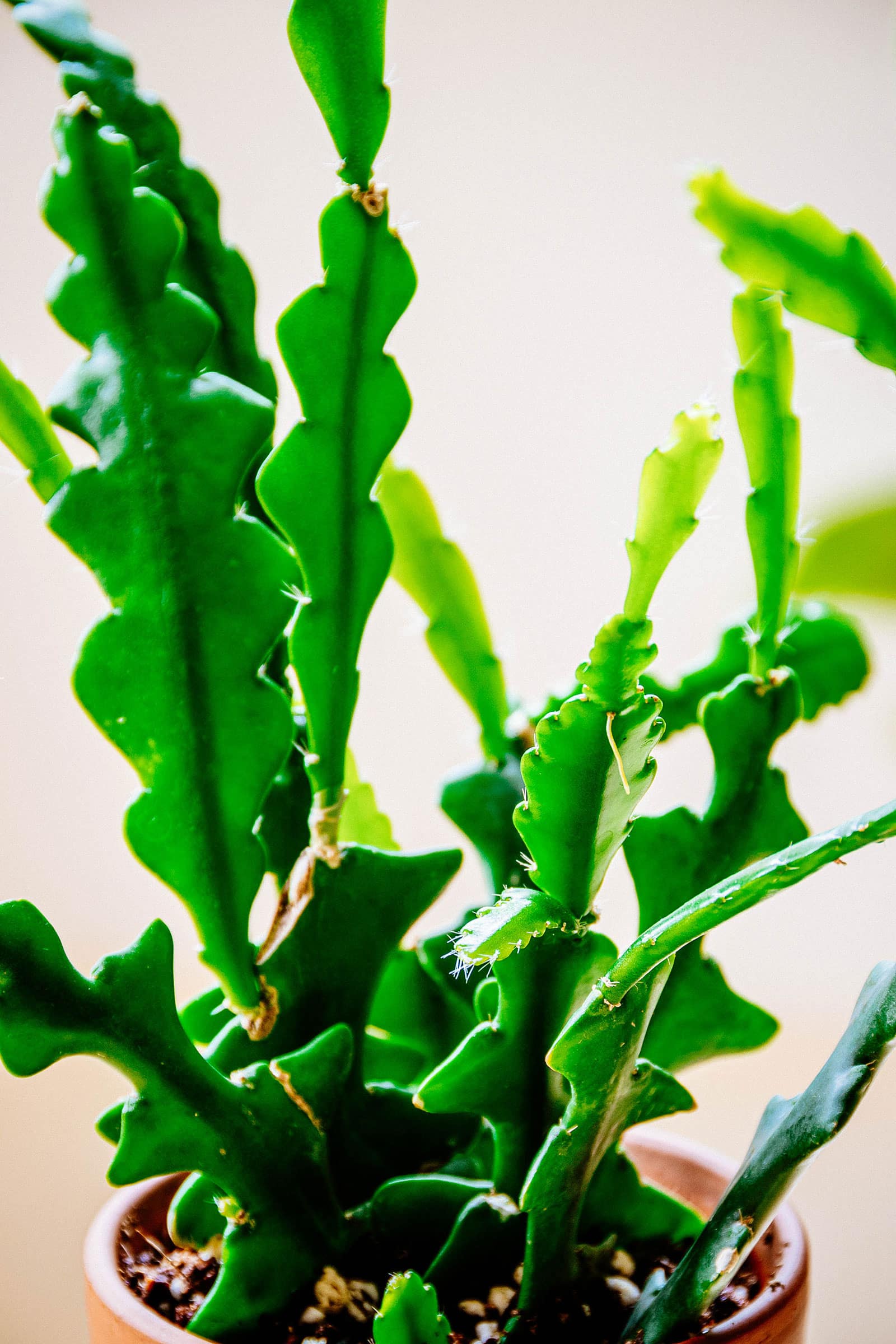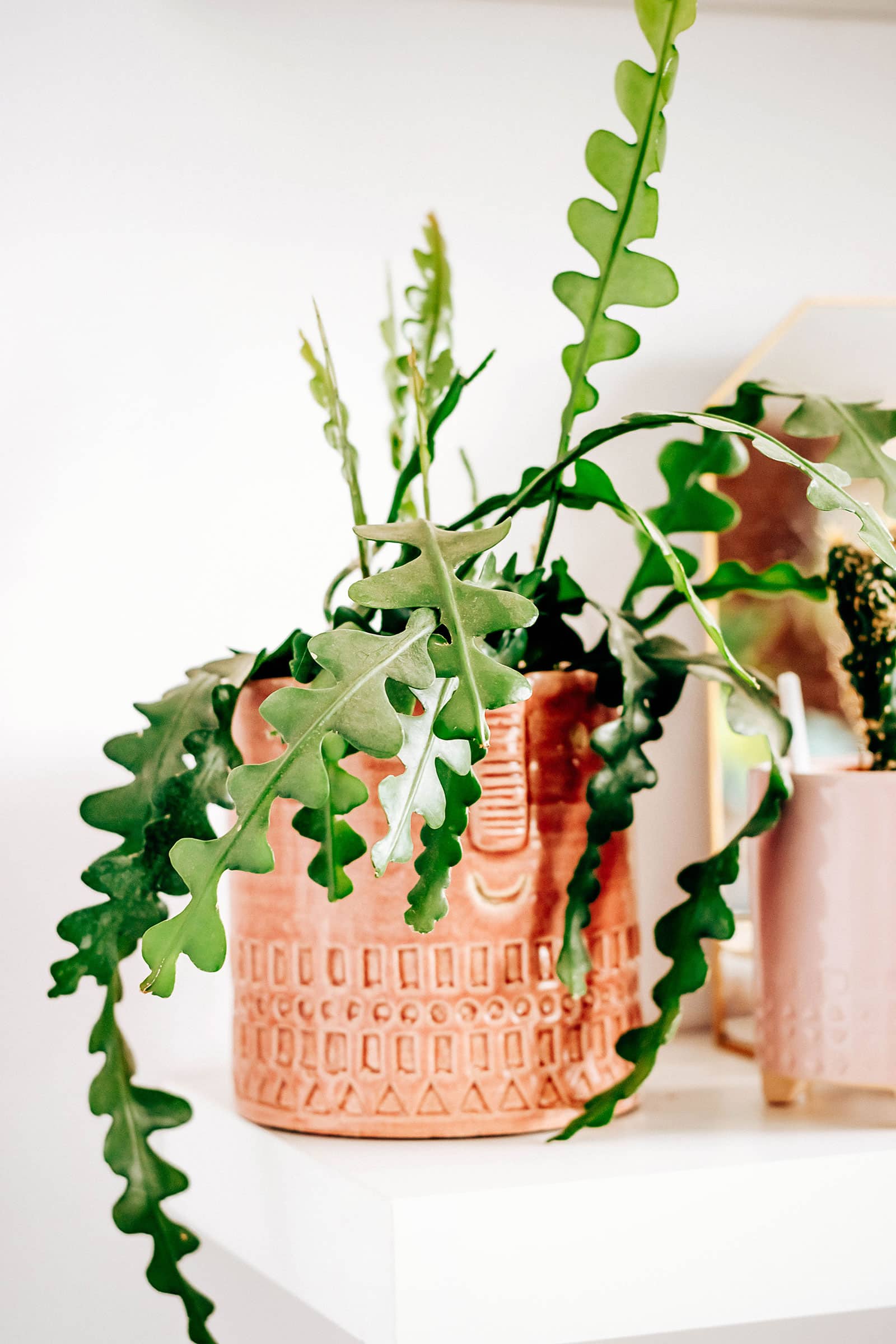Looking for an unusual, funky-leaved houseplant to add to your collection? I’ve got just the thing for you: Disocactus anguliger (formerly Epiphyllum anguliger), also known as the fishbone cactus.
Coveted for its zig-zagging leaves and breathtaking blooms, this jungle cactus is full of personality and has taken the houseplant world by storm.
Here’s what you need to know about fishbone cactus care and how to keep this eye-catcher alive indoors.
| Common name(s) | Fishbone cactus, zig-zag cactus, ric-rac cactus |
| Scientific name | Disocactus anguliger, formerly Epiphyllum anguliger |
| Family | Cactaceae |
| Height & spread | Up to 3 feet long and 1 foot wide |
| Light | Bright indirect |
| Soil type | Airy and well-draining |
| Water | Keep lightly moist |

About the fishbone cactus
Description
When thinking of cacti, humidity-loving forest dwellers that live on trees aren’t the first thing that comes to mind for most people. And yet, that’s exactly what the fishbone cactus is!
Like its popular cousins Epiphyllum (orchid cactus), Rhipsalis (coral cactus), and Schlumbergera (holiday cactus), Disocactus anguliger is a jungle cactus.
Similar to other other jungle cacti in looks, this one is characterized by its flat, segmented foliage. The difference is that, as its name suggest the leaves on the fishbone (or zig-zag, ric-rac) cactus are strongly serrated. In a normal planter, the leaves hang downward, but they can also be made to climb up a piece of wood.
All this makes for a pretty cool-looking houseplant, especially considering the species also blooms beautifully. Its large star-shaped flowers are naturally white, but selective cultivation has led to a range of different colors including yellow, orange, pink and even multicolored.
Did you know?
There is a cactus species that belongs to the same tribe (Hylocereeae) and looks very similar to the fishbone cactus: Selenicereus anthonyanus. They even share a lot of the same common names! The difference is in the flowers, as those of Selenicereus are naturally bright pink and cream in color rather than D. anguliger’s off-white and yellow.
If you’re not sure whether you’ve got a Selenicereus or a Disocactus on your hands, don’t fret. The care requirements for these two species are pretty much identical, so you can use the instructions in this guide for either.
Natural habitat
This cactus is naturally found in Mexico, where it occurs in the states of Jalisco, Oaxaca, Guerrero, and possibly Nayarit and/or Michoacán. It prefers humid forested regions at relatively high elevations, usually between 3,600 and 5,900 feet.
In its montane forest habitat, the fishbone cactus doesn’t grow in the soil like most plants do. Instead, it’s an epiphyte, meaning it (non-parasitically) uses taller trees as supports as it climbs its way to the forest canopy. (Epiphytes are quite popular in the houseplant world; other favorites you might know include Hoyas and Tillandsias.)
Fishbone cacti appear to like oak trees in particular, maybe because they tend to leach more nutrients from their foliage than many other tree species do.
The IUCN lists this cactus as a species of Least Concern, noting it’s common in its natural habitat. It does mention that its natural habitat is under pressure due to excessive cattle grazing and increased forest fires.
So is this a Disocactus or an Epiphyllum?
If you’ve been collecting houseplants for a while, you likely know the fishbone cactus as Epiphyllum anguliger. What’s up with the whole Disocactus anguliger thing?!
Well, that’s plant naming for you: it’s ever-changing and quite frankly, a total mess at times.
What happened is that molecular research revealed in 2016 that a bunch of the members of this genus weren’t actually Epiphyllums after all, and that they fit better in the genus Disocactus. The fishbone cactus was one of them, hence its name change.

Types of fishbone cacti
Flowering houseplants like this one are normally irresistible to nurseries: they can be selectively bred and hybridized to produce all sorts of different flower colors and shapes, not to mention variations in foliage.
Related: Take a look at these cactus varieties with amazing flowers
It seems that plenty of different fishbone cactus cultivars do indeed exist, but strangely enough, they don’t appear to be particularly popular outside of clubs dedicated to growing them. It’s not like with Epiphyllums, where it sometimes feels like you’re going to drown in funky-named plant variations: Disocactus anguliger is usually just sold as “fishbone cactus,” nothing more and nothing less.
I was able to identify a few types of fishbone cacti:
- Disocactus ‘Red Tips’: As the name suggests, this cultivar develops orangey-red tips if it’s exposed to enough light.
- Disocactus ‘Jalisco’ series: Produced by Rudolf Hessing, these hybrids have fine flowers in different colors.
- Disocactus ‘El Tecolote’: Large, creamy white blooms.
Where to buy
Fishbone cacti

Caring for a fishbone cactus
Light and temperature
Unlike desert cacti, fishbone cacti and other jungle cactus species don’t need tons of sun. They naturally grow under the forest canopy, meaning the harshest rays are filtered out. Don’t be fooled into thinking you can grow your Disocactus in a dark corner, though!
The best indoor location for a jungle cactus is a window that receives bright indirect light. Some direct sun won’t be an issue, as it’s not nearly as bright through a window as it would be outdoors. If you grow your cactus outside during the summer, it does become more important to find it a sheltered spot to prevent it from burning.
In terms of temperature, this species isn’t too fussy, but it’s definitely not frost hardy. Temps between 59°F to 86°F are preferable for good growth. This being said, your fishbone cactus will benefit from cool temperatures (between 50°F to 55°F) during winter, as the chill encourages blooming.
For the best results, if need be, move your cactus to a cooler location in your home around December. Once buds start to form, usually around February or March, you can slowly acclimate it back to its normal, warmer position. With some luck, this will stimulate it to bloom off and on throughout the upcoming summer months!
Water and humidity
When caring for a jungle cactus, it’s important to keep in mind that they like quite a bit more water than desert cacti. However, because they’re naturally epiphytes, they definitely haven’t evolved to be stuck in constantly wet soil either. It’s all about balance.
I can’t say exactly how often to water your Disocactus, as this depends on factors like the amount of light it receives and the type of soil mixture it’s in. You’ll have to gauge the moisture level yourself in order to figure out when your cactus needs a drink.
- During the late spring to early autumn growing season, water a fishbone cactus whenever the first 2 to 3 inches of the soil have gone dry. This will usually be around once a week or so, but it may be sooner in warrm climates.
- During winter, when the plant is likely not actively growing, wait until the soil has gone at least halfway dry. This will usually be around once every two weeks, but it may take even longer.
If the leaves on your fishbone cactus are looking dry, wrinkly, and crispy, especially at the tips, your plant may need more water or is unable to take up water properly as a result of some kind of root damage.
If the leaves are soft and discolored, you’re overdoing it and it’s succumbing to rot. You may have to use the methods described in the section on propagating a fishbone cactus in order to save what you can.
As for humidity, the forests this species naturally inhabits tend to be quite moist. In the home, it’s not hugely fussy, but it can suffer if the air is very dry. You could consider running a humidifier if the relative humidity level regularly drops below 40 percent in your home.
Soil and planting
As you’ve probably concluded at this point, jungle cacti and desert cacti are quite different. They do have one thing in common, though: a preference for light and gritty soil. Desert cacti need airy soil because it promotes drainage; jungle cacti need it because as epiphytes, they don’t respond well to their roots being choked in a dense mixture.
It’s easy enough to create your own soil mix that can be used for all sorts of cacti and succulents, including the fishbone cactus. There are lots of different ingredients and amendments you can use, but something basic would look a little like this:
- 2 parts houseplant potting soil
- 1 part perlite or pumice
- 1 part fine orchid bark
Your fishbone cactus will likely also appreciate the addition of a handful of compost or worm castings.
When it comes to pots and planters, that’s up to your own tastes. As long as the container you keep your fishbone cactus in has a drainage hole, your plant should do fine. Most houseplant enthusiasts prefer to grow this species in a hanging planter so its long leaves can spill over the edges.
As mentioned earlier, though, you can also mount yours on a nice piece of driftwood for a more natural display. Some spaghnum moss can help keep the roots moist enough.
Recommended products for fishbone cactus care:
- Leaves & Soul Premium Potting Soil for Orchids, Bromeliads, and Epiphytic Plants
- Espoma Organic Potting Mix for Orchids and Bromeliads
- Good Earth Organics Premium Potting Soil
- Perfect Plants Organic Perlite
- Wiggle Worm Pure Organic Worm Castings
- Better-Gro Orchid Bark
Fertilizing
Fishbone cacti don’t need a lot of fertilizer, but like almost all houseplants, they do appreciate some extra nutrients at long as they’re given at the right time. You can use a water-soluble, diluted houseplant food or cactus fertilizer once a month or so during the growing season.
Stop fertilizing during the inactive winter months, with the exception of once during early spring. Right before you move the plant back to its normal location, you can give it some plant food to encourage blooming. A diluted orchid fertilizer should work well here.
Recommended fertilizers for fishbone cactus care:
- Elm Dirt Plant Juice Organic Fertilizer
- The Grow Co. Succulent & Cactus Plant Food
- Cute Farms Cacti, Succulent & Aloe Fertilizer (Liquid Pump Bottle)
- Espoma Organic Orchid Bloom Booster
Pruning
Unless you just want to remove some dead foliage, there’s no need to prune your fishbone cactus. Let it grow big and wild!
Dividing or repotting
The fishbone cactus is a good candidate for division, which is a helpful method if yours is outgrowing its planter but you don’t want to move it to a larger pot. Just take the cactus out of its container, shake the soil off the roots, and divide it into as many clumps as you want (slice vertically through the root ball with a clean knife if need be).
Once you’ve divided your Disocactus, you can place each clump in a planter with some fresh soil. Since the plants already have roots, they should keep growing as usual.
If you prefer to see how big you can get your fishbone cactus to grow, division is obviously not the way to go. In this case, you can go up one pot size whenever your plant outgrows its current container. The soil should be refreshed at least every other year.

Propagating a fishbone cactus
One thing I love about jungle cacti like this one is how easy they are to multiply. Propagating a fishbone cactus is a matter of removing a single leaf, or even just part of a leaf, from the mother plant!
All you have to do to obtain a new fishbone cactus is use some clean scissors or shears to snip off one or more piece(s) of at least 2 to 3 inches in length off an existing plant. Stick the cutting(s) in a small planter with some suitable soil. Place in a nice and light windowsill and lightly spray daily.
After a week or two, give the cutting(s) a light tug. If you feel any resistance, that means they’ve rooted and you can switch to a normal fishbone cactus watering schedule. If there are no roots present yet, just wait a little longer: it can take a while, especially during the cooler and darker winter months.
Once you see new growth on a leaf cutting, you can be sure your propagation attempt has been a success. Congrats, you obtained a brand new fishbone cactus for a whopping $0!

Common questions about fishbone cactus care
Is the fishbone cactus toxic to cats and dogs?
Nope, fishbone cacti are pet-friendly! You can safely grow this plant around pets or children. In fact, it even produces edible fruits. Reminiscent of dragonfruit but much smaller, fishbone cactus fruit is said to be quite tasty.
Does the fishbone cactus flower?
As I’m sure you’ve concluded by now, the answer to this question is a resounding yes. Disocactus anguliger is a part of the epiphytic cactus tribe Hylocereeae, which is known specifically for its showy blooms.
Sources:
- Boerner, R. E. J. (1984). Foliar nutrient dynamics and nutrient use efficiency of four deciduous tree species in relation to site fertility. Journal of applied ecology, 1029-1040.
- Cruz, M. Á., Arias, S., & Terrazas, T. (2016). Molecular phylogeny and taxonomy of the genus Disocactus (Cactaceae), based on the DNA sequences of six chloroplast markers. Willdenowia, 46(1), 145-164.















